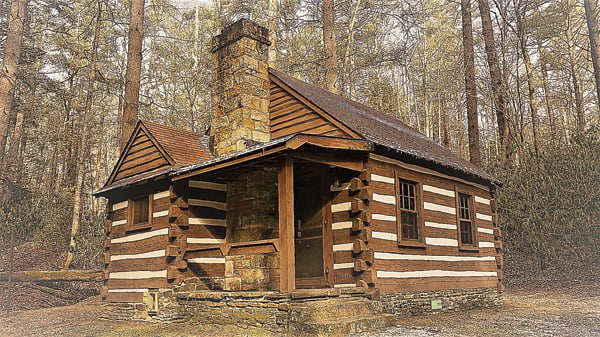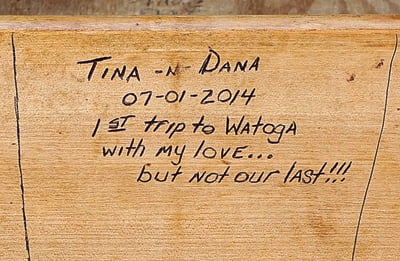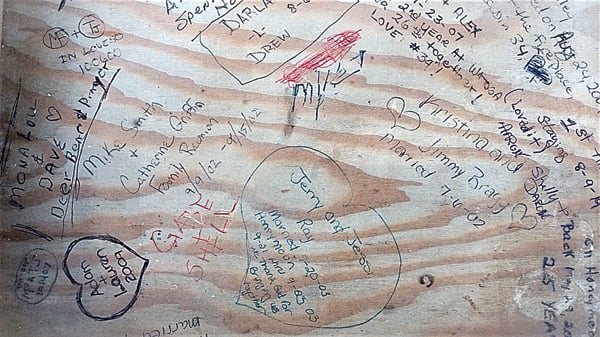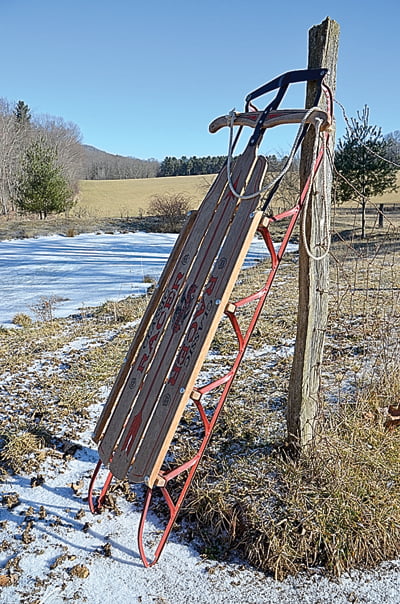
The Honeymoon Cabin at Watoga State Park has been the site of many wonderful and romantic getaways for couples from all around the world. Situated a respectable distance from other cabins, surrounded by trees and rhododendron and bordered by a deep wood, this cabin speaks to those in search of the perfect location for romance and intimacy. Left, through the decades, “love notes” have become a part of the décor.

Ken Springer
Watoga Park Foundation
The Honeymoon Cabin
Judy was born and raised in Ashtabula, Ohio. She was the first generation of her Finnish immigrant family to be born in the U.S., and she remembers an aunt who talked incessantly about Chicago at any and all family gatherings.
The aunt spoke of the architecture and stores along Michigan Avenue and the many museums. She was particularly fond of the Field Museum of Natural History, often going on for hours about one display or the other. Her stories never varied in the details of her various experiences in the Windy City. Over the decades, they had become well-rehearsed lines.
Judy grew up assuming that her aunt had lived in Chicago at some point in her life. She seemed to know it so intimately. Perhaps, Judy speculated, she had some sort of career there before she came back to Ashtabula to marry and raise five children.
When her aunt died, Judy came home from college to Ashtabula for the funeral. It was there that she learned that her aunt, this woman who so often professed her love for Chicago, had only been there for a total of four days. She had gone to Chicago by train with other young women on a chaperoned school trip.
Judy’s aunt never returned to Chicago after that single trip. Other than that, she had only traveled from Ashtabula to nearby Cleveland for the entirety of her 87 years. Yet, that single visit to Chicago left such an indelible impression on her that she could recall her limited experiences there with exceptional clarity for more than 70 years.
For Judy’s aunt, that experience had stretched out the passage of time well beyond those four short days. The brief time spent in Chicago had become an inordinately large part of her personal history. The associated memories gave her lasting joy and a sense of identity beyond her immediate environment in rural Ashtabula.
We all experience these episodic memories to some degree or the other. Episodic memories are often very vivid when recalled. They can be good memories such as our honeymoon, or bad memories such as the loss of a loved one. Rarely do such memories affect us as they did Judy’s aunt.
Good memories are cherished though, and when we retrieve such memories the brain rewards us by releasing dopamine, the “happy” hormone. At times, a pleasurable memory can drive us to revisit the very place where the memory was made – a nostalgic trip down Memory Lane, if you will.
Today, we will take a look at a small log cabin in Watoga State Park that played host to many wonderful and romantic memories for couples from all over the world. And, as we shall see, there is ample evidence within the walls of this little cabin to prove it to be a place where memories are made.
When the park first opened in 1937, there were 18 cabins open to the public. Built a couple of years earlier out of local hardwoods and blight-killed American Chestnut, meticulous care was given to achieving the authenticity of early pioneer cabins. The results were rustic log cabins with native-stone fireplaces that literally beckon visitors to stay.
One of these cabins can be found in Pine Run Campground at the very end of a park road. It is somewhat smaller than most of the other cabins that were designed to provide lodging for an entire family.
It is situated a respectable distance from other cabins, surrounded by trees and rhododendron and bordered by a deep wood. Dubbed the Honeymoon Cabin, this cabin is the epitome of the cozy little cabin in the woods, and it speaks to those in search of the perfect location for romance and intimacy.
It is easy to imagine this rustic cabin in the early evening with the lights low and smoke curling up from the chimney. Viewed from the outside it would put one in mind of a Currier and Ives scene.
It is also easy to imagine young newlyweds curled up together in front of the fireplace, a blanket wrapped around them as they stare dreamily into the flames. The many facets of the bride’s four-carat diamond wedding ring are reflected in their eyes by the flickering fire.
The young bride imagines, “We can now start our own little family. Perhaps this very evening, right here in this beautiful cabin.”
While he thinks, “It is going to take me the rest of my life to pay for that ring.”
Well, you really didn’t expect a flawless imaginary scene, did you?

If you are looking for a storybook cabin in the woods where you can spend time with someone you love, look no further than the Honeymoon Cabin at Watoga. As you unpack and settle in, you will be delighted to see messages discreetly left by those who spent time there in years past. There seems to be an innate need for humans to leave a record of their experiences in places that they deem special – and so they have – at Watoga State Park.
It is not that the Honeymoon Cabin is only rented to honeymooners, it’s not. But those chestnut logs have borne witness to the first days of countless marriages and has observed the many and varied aspects of human romance.
Some visitors return year after year to this particular cabin with their significant other. It serves as a ritual of reaffirming their love and commitment to each other.
We know these things have happened there because these visitors leave a little something behind. This little cabin in the woods has a documented romantic history, one hidden from plain view for many decades.
The Honeymoon Cabin has a two-seat drop leaf table in which there are two drawers. If you pull the drawers out, you will reveal hundreds of small testimonials written by visitors over many years. These are all authored by romantics, honeymooners and those returning for anniversaries.
Stored somewhere within the park is an original chest-of-drawers that was in the cabin since it was first opened to the public in 1937. The drawers of which are also festooned with similar testimonials, differing only in that they came from an earlier time period.
Here are a few examples of these messages of love:
“We needed some time away from the kids, dogs, and everyday chores. I love Johnny with everything in me. Always and forever!!! Johnny and Katie = (image of heart)”
“Recently married, this is our romantic getaway here in Honeymoon Cabin. I love her more each day. Jamie and Christina.”
“Here May 19, 1981, on Honeymoon. Back May 29, 2006, 25-year anniversary, Jim and Sally.”
“On Honeymoon. From high school sweethearts tolong lasting soulmates. Forever and a day in love. Gary and Donna.”
“Back here for 20th anniversary in our ‘sweet’, ‘sweet’ Watoga park… back again for our 25th anniversary.”
“A beautiful escape from reality. The Honeymoon Cabin is the perfect place to make memories (image of heart) Dustin and Sarah”
“What a honeymoon. It was God that brought us together. We are so happy to be together and we enjoy each other so. Ronald and Bonny.”
Someone will inevitably raise the question – are these charming expressions of love or just graffiti? Perhaps, in the strictest sense of the word, they are graffiti. However, just for a moment imagine that you are a first-time visitor to the Honeymoon Cabin. You are there with a loved one.
You have brought in your luggage and set it down. Your mind is on the days ahead; you have found a storybook cabin in the woods to spend time with someone you love.
What delight awaits you when you open these drawers and start to read these messages that came from the hearts of others, people much like yourself.
There seems to be an innate need for humans to leave a record of their experiences in places that they deem special. More than 9,000 years ago, humans were leaving their handprints on the wall of a cave in Argentina as a way of documenting their visit.
Most climbers attempting a climb of the Grand Teton in Wyoming spend their first night on a windswept narrow ridge called the Lower Saddle. The elevation there is 11,600 feet above sea level and staying there allows climbers an early start the next morning on their ascent to the summit at 13,776 feet.
My climbing partner and I were pinned down by a two-day snowstorm there once and found some shelter from the storm in a small cave. In the back of this rock grotto, we found a large pile of smooth rounded stones. These stones were not at all like the angular rocks that made up the mountain at this elevation – they had been brought there from a streambed, we knew that much.
But it was still a mystery to us as to how and why these stones got to this spot that is so difficult to reach, even for experienced climbers.
The mystery was solved several days later when I happened to tell a Native American man about the stones. He smiled and told me that his people call them “talking stones.” He compared them to business cards, saying that it is a difficult hike to the Lower Saddle and they simply left a talking stone to tell others of their accomplishment.
So maybe we can think of all of those hundreds of messages of love in the Honeymoon Cabin as simply “talking stones.” Our way of celebrating and announcing to the world that this particular little spot on the Earth holds great importance to us personally.
My wishes to you for a very happy Valentine’s Day.
If you would like more information on the Honeymoon Cabin, please contact Watoga State Park at 304-799-4087 or online at wvstateparks.com/park/Watoga-state-park/
From the trails of Watoga State Park,
Ken Springer
Ken49bon@gmail.com



